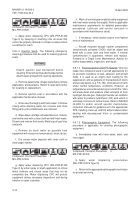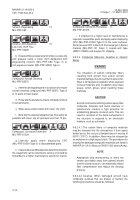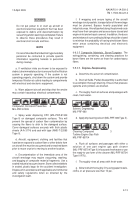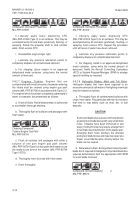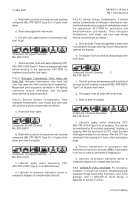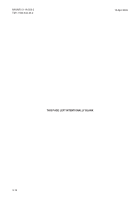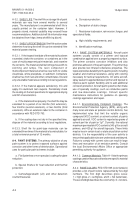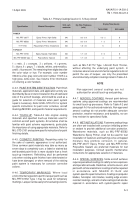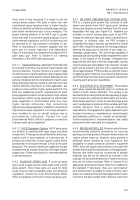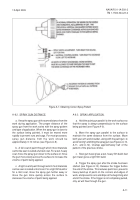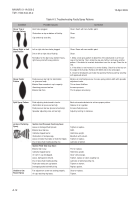TM-1-1500-344-23-2 - Page 173 of 240
A-3
NAVAIR 01-1A-509-2
TM 1-1500-344-23-2
15 April 2009
1 = reds, 2 = oranges, 3 = yellows, 4 = greens,
5 = blues, 6 = grays, 7 = blacks, whites, and metallics,
and 8 = fluorescent. The remaining three digits describe
the color value or hue. For example, color number
36440 is a flat, gray color and color number 17925 is a
high gloss, white color. See Volume IV for information
on ordering a color fandeck.
A-4.3. PAINT SYSTEM IDENTIFICATION. Paint finish
materials, application date, and application activity are
identified by decal or stencil located on the aft starboard
side of the aircraft fuselage, and should be used as a
guide for selection of materials when paint system
repair is necessary. Refer to MIL-STD-2161 or system
specific instructions for paint color schemes, aircraft
markings/MODEX, and specific material requirements.
A-4.4. TOUCH-UP. Table A-2 lists original coating
materials and specified touch-up materials used for
common aircraft paint systems. All activities shall be
familiar with paint scheme requirements, particularly
the importance of using appropriate materials. Refer to
MIL-STD-2161 and system specific instructions for paint
finishing details.
A-4.5. COSMETIC PAINTING. Repainting solely for
the sake of cosmetic appearance is not authorized.
Since common paint materials may take as many as
seven days to completely cure, a faded or stained but
well-bonded paint finish is more durable than a fresh
touch-up treatment. Refinishing shall be performed
only when existing paint finishes have deteriorated or
have been damaged, or when removal of the existing
paint system is necessary for corrosion corrective
actions.
A-4.6. TEMPORARY MARKINGS. Where local
environmental regulations permit, lacquer paint such as
MIL-PRF-81352 Type I may be used for temporary
markings. Lacquer can be easily removed using solvents,
such as MIL-T-81772 Type I Aircraft Paint Thinner,
without affecting the underlying paint system. In
instances where local environmental regulations do not
permit the use of lacquer, use only the prescribed
environmentally compliant coatings listed in Table A-2.
NOTE
Non-approved aerosol coatings are not
authorized for aircraft touch-up and painting.
A-4.7. AEROSOL COATINGS. Aerosol paint delivery
systems using approved coatings are recommended
for small touch-up processes. Refer to Table A-2 and
paragraph A-9 for authorized materials. Non-approved
aerosol coatings do not provide adequate corrosion
protection, weather resistance, and durability, nor are
they resistant to operational fluids.
A-4.8. WET INSTALLATIONS. Fasteners and bushings
are often wet-installed with corrosion inhibiting primer
or sealant to provide additional corrosion protection.
Waterborne materials, such as MIL-PRF-85582
Waterborne Epoxy Primer, shall not be used for wet
installation of fasteners and bushings since entrapped
moisture may promote corrosion. In general,
MIL-PRF-23377 Epoxy Primer and MIL-PRF-81733
Polysulfide Sealant are preferred materials for wet
installation purposes. Consult specific maintenance
instructions for appropriate selection of materials.
A-4.9. SPECIAL SURFACES. Some aircraft surfaces
require specialized coatings to satisfy service exposure
and operational needs. Radomes, antenna covers, and
parts with similar elastomeric coatings shall be repaired
in accordance with NAVAIR 01-1A-22 and
system-specific repair instructions. Coatings on propeller
blades, helicopter rotor blades, leading edge erosion
resistant coatings, and anti-chafe coatings shall also be
repaired in accordance with system-specific repair
n
o
i
t
a
c
i
f
i
c
e
p
S
n
o
i
t
p
i
r
c
s
e
D
l
a
i
r
e
t
a
M
)
l
/
g
(
,
C
O
V
m
u
m
i
x
a
m
s
s
e
n
k
c
i
h
T
m
l
i
F
y
r
D
)
s
l
i
m
(
)
s
r
u
o
h
(
e
m
i
T
g
n
i
y
r
D
E
E
R
F
K
C
A
T
D
R
A
H
Y
R
D
R
E
M
I
R
P
7
7
3
3
2
-
F
R
P
-
L
I
Ms
d
i
l
o
S
-
h
g
i
H
,
r
e
m
i
r
P
y
x
o
p
E0
4
39
.
0
-
6
.
02
-
2
/
18
2
8
5
5
8
-
F
R
P
-
L
I
Me
n
r
o
b
r
e
t
a
W
,
r
e
m
i
r
P
y
x
o
p
E0
4
39
.
0
-
6
.
02
-
16
0
6
7
2
-
P
-
T
Tc
i
r
e
m
o
t
s
a
l
E
,
r
e
m
i
r
P
e
n
a
h
t
e
r
u
y
l
o
P0
4
30
.
2
-
5
.
15
8
T
A
O
C
P
O
T
0
5
7
2
2
-
F
R
P
-
L
I
Ms
d
i
l
o
S
-
h
g
i
H
,
t
a
o
c
p
o
T
y
x
o
p
E0
4
33
.
2
-
7
.
16
-
28
I
e
p
y
T
5
8
2
5
8
-
F
R
P
-
L
I
Mt
a
o
c
p
o
T
e
n
a
h
t
e
r
u
y
l
o
P0
2
43
.
2
-
7
.
14
2
1
Table A-1. Primary Coatings Used on U. S. Navy Aircraft
Back to Top


